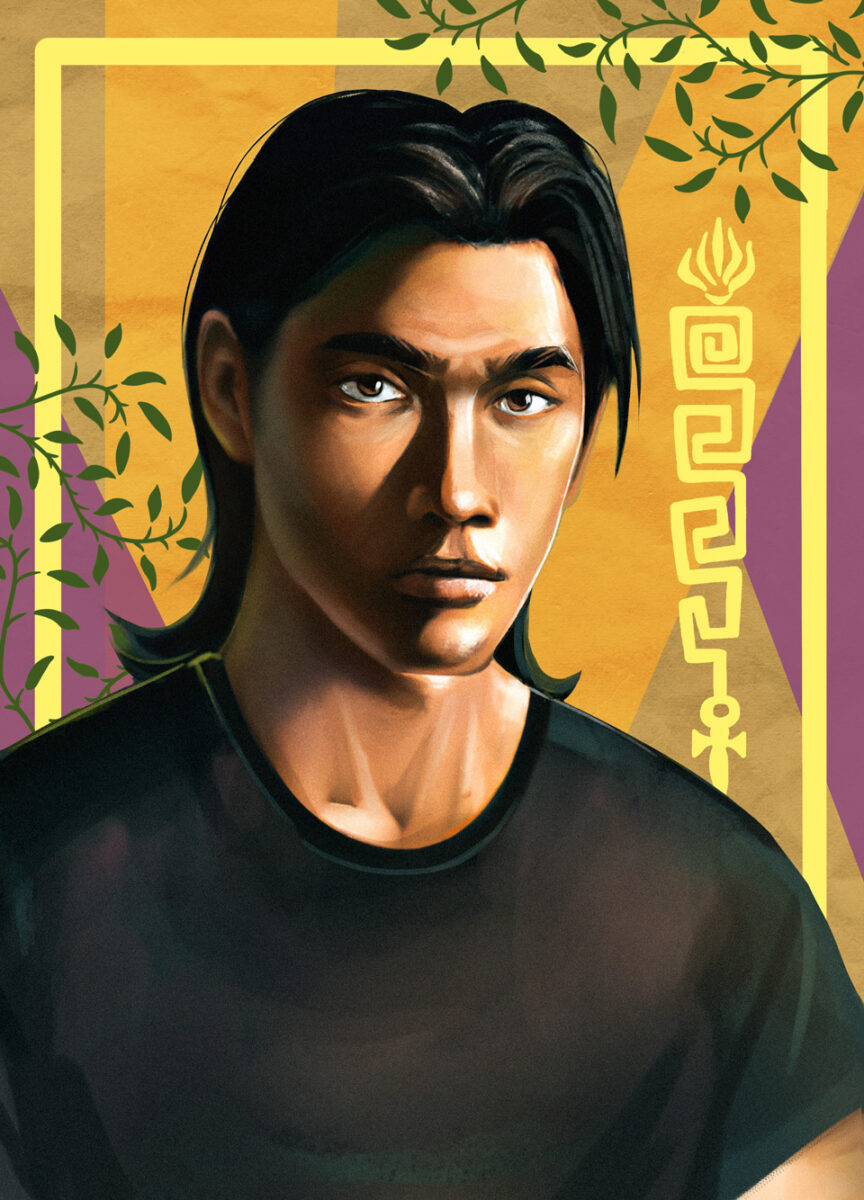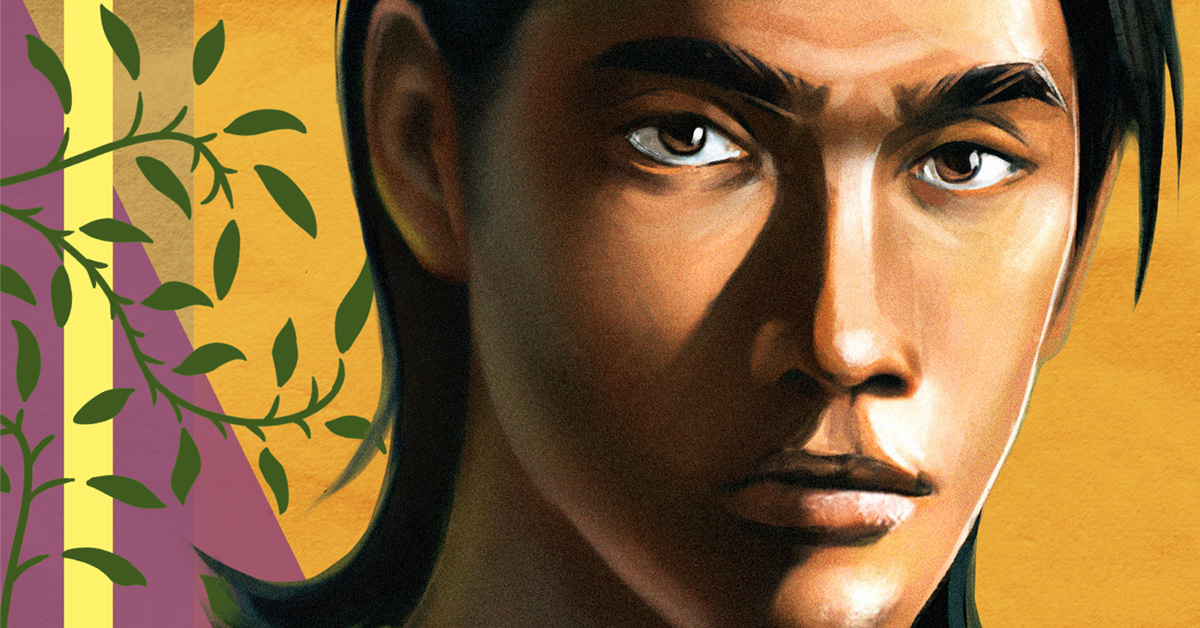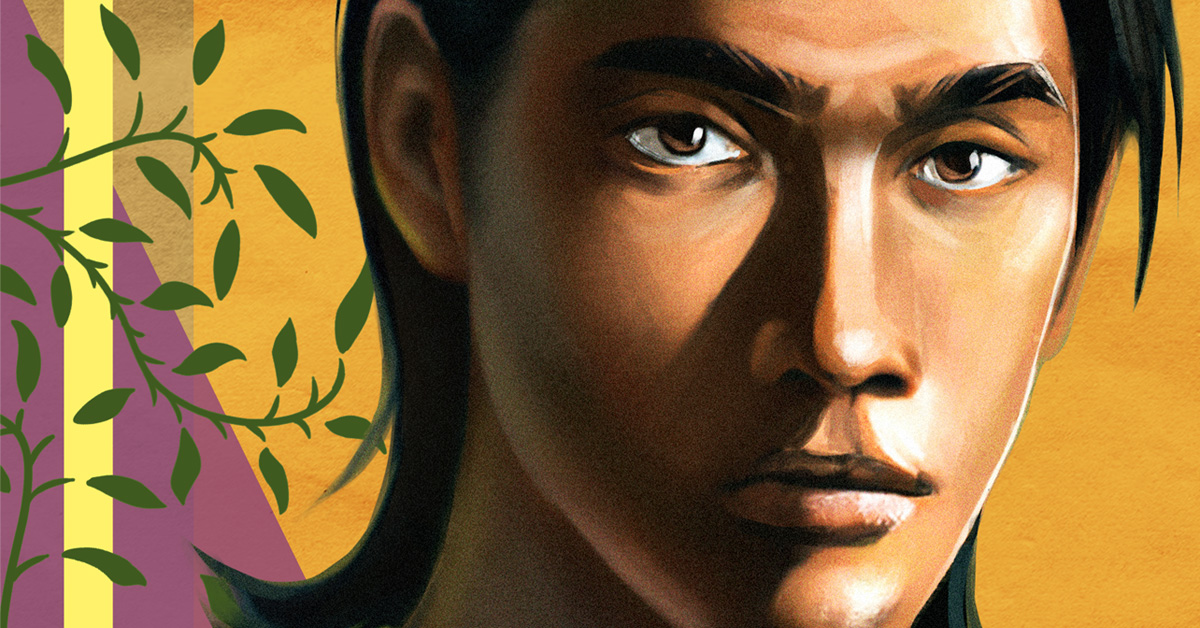The Kiss
In Chapter 56 of the Noli Me Tangere, soldiers armed with bayonets arrive at the old Ibarra house and bang on the main door. Inside, Elias decides to burn the letters that may be used against his friend Crisostomo Ibarra.
Before he escapes the burning house, Elias “buckled on the weapons, kissed Maria Clara’s portrait, and then put it in one of the sacks.”
Kissed Maria Clara’s portrait? Elias is attracted to Maria Clara? I don’t think we ever discussed this when I studied the Noli in high school. I paused the Audible book narrated by actor Richard Grant and replayed it. Elias really kissed. I looked at my printed copy of the Leon Maria Guerrero translation which is the source of the Audible book. Yes, the kiss was there. It confirmed my feeling that something was going on between Elias and Maria Clara at the picnic scene, something which I also only caught while listening to Audible. I decided to revisit Chapter 23, titled the Fishing Expedition where Elias first sees Maria Clara.

Rizal introduces Elias
Long before we learn that Elias, like Ibarra, is also Jesuit-educated, we first meet him as a pilot or steersman.
“He was a youth with an athlete’s body and a face made interesting by great sad eyes and a stern mouth. His long unkempt black hair fell to his strong neck. The creases of his coarse dark shirt suggested the powerful muscles that helped his bare sinewy arms handle, as though it were a feather, the enormous oar that served as a rudder for the two boats.“
The Picnic Goers
Maria Clara sits beside her fiancé and childhood playmate Ibarra in one of the boats steered by Elias. Ibarra had recently arrived from abroad after being away for seven years. The young couple and their friends are on a picnic. As the novel is set in the 19th century, the young women are chaperoned by their mothers and aunts and accompanied by helpers bringing kitchen and dining paraphernalia.
Maria Clara, 20, had just left convent school after living there since she was 13. Now that she’s out in public again, she is curious about everything and everyone. The pilot who has sad eyes and who remains indifferent to the fun of the party intrigues her.
“María Clara had surprised him more than once studying her. He would then instantly turn his face away and look out into the distance, to the mountains, to the shore.”
The Beautiful and the Enigmatic
Author Dr. Jose P. Rizal immediately establishes that Maria Clara has captivated Elias. The rumor of Maria Clara’s great beauty precedes her, so that Elias, who beholds her beauty for the first time, looks, admires, and stares.
“She took pity on his loneliness and offered him some biscuits. The steersman gave her a startled look, but it lasted only for a second. He took one biscuit and thanked her briefly in a voice that was scarcely audible.”
Then, Rizal says no one bothered about the pilot after that. And I thought, that is that. It was just kindness that inspired her to approach Elias.
But soon,
“María Clara followed the herons with her eyes as they flew off toward the neighboring mountain upon the approach of the boats. ‘Do those birds nest on the mountain?’ she asked the steersman, more perhaps to make him speak than to know the answer.”
She wants to hear him speak! Is she interested in Elias or just wants him to join in on the fun of the party? Well, Elias does not disappoint her, nor us readers, because he speaks of a myth about the herons, enhancing his enigma.
“They say, ma’am, that the nests of these birds are invisible and can make their possessors equally invisible; that, like the soul which can be seen only in the clear mirror of the eyes, these nests can be seen only in the mirror of the waters.”
The Wrestle with the Reptile
Soon the party arrives at a fish trap devoid of fish because a crocodile has invaded its depths. Someone suggests catching the reptile.
“’I have never seen a live crocodile,’ said María Clara.
“The steersman stood up, took a long rope, and climbed nimbly to the platform. León made way for him.”
Uyyyy, I thought. Elias is out to impress Maria Clara! Leon estimates the reptile to be a big one, but its size does not daunt Elias.
“Only María Clara had noticed him so far; now everyone admired his splendid figure.”
Ahem. Rizal finally spells out the attraction. And this is happening under the nose of Ibarra! The Maria Clara we see here does not jibe with the one we are familiar with. The high school student, even without opening the book, knows her as chaste. Wikipedia describes her as the ideal woman of virtue; and like any ideal, nearly impossible for a student to emulate. But in this scene, we can drop the word ideal and see her as someone relatable: a woman.
“Then to everyone’s surprise he dived into the trap, ignoring all the cries of warning… ‘Don’t worry, ladies,’ the old boatman said, ‘If there’s anybody in this province can do it, he can.’”
The Bromance
Elias single-handedly wrestles the crocodile up the platform with his rope, but it whips its tail and drags Elias into the water again. The hero of the day isn’t Elias but Ibarra who jumps into the water too and stabs the crocodile.
Elias thanks Ibarra and thus begins the bromance between the two men who both wish to be catalysts for change in Philippine society.
How the Day Ends
Ibarra brings the picnic to a forested area on his property. In the afternoon, we learn that Elias, who had already left the party, is wanted by the Civil Guard. Maria Clara doesn’t think him a tulisan or bandit, though, “‘but he has a brooding look. I didn’t see him smile the whole morning.’”
The sun sets on this day with Elias visiting his sweetheart, Salome. She asks Elias if there were pretty girls at the picnic. She does not appear jealous, though, just eager to experience vicariously the fun at the picnic.
“’There was one… the fiancée of the rich young man who has just come back from Europe,’ answered Elias indistinctly.
‘‘’Oh, I know, the daughter of the rich Capitán Tiago! They say she has turned out a real beauty!’
“‘Oh yes, very beautiful and very kind, he replied, stifling a sigh.’”
Elias and Maria Clara
And that is all that happened between Elias and Maria Clara. I thought it odd, though, that Rizal did not make any of Maria Clara’s friends notice the flirtation at the picnic. Did I read Rizal wrong?
Five chapters later, Rizal hints that I read him right. In At Nightfall, Maria Clara with her girlfriends, chaperoned by Tia Isabel, and Ibarra walk about town before the last day of the fiesta. After drinking tsokolate, the girls walk beside each other and talk about the Lieutenant’s wife Dona Consolacion. Sinang, who is a keen observer, speaks of Dona Consolacion:
“’I could never stand her, and even less after she spoiled our outing with those stupid soldiers of hers. If I were the Archbishop, I’d marry her off to Father Salvi. Their children would be something to see! Just fancy, having that poor steersman arrested who threw himself into the water just to please…”
…______? Rizal is a tease. He distracts Sinang and does not let her finish her sentence.
The Full Strength of Her Love
Midway through the novel, Ibarra is ex-communicated from the Catholic Church and Maria Clara is asked by her father to marry someone else. While she loved Ibarra since they were young, it is at this point of forced separation that Rizal says Maria Clara realizes the “full strength” of her love for him.
Maria Clara and Ibarra’s last meeting occurs on her balcony by the Pasig. Ibarra has just escaped prison with the help of Elias and while the lovers speak, Elias waits in a banka. The couple gets the chance to clarify their intentions and love especially since Ibarra’s letter to Maria Clara was used by the authorities against him. Even when she is engaged to Linares, she promises to remain faithful to Ibarra.
“’I love only once, and I shall never belong to anyone without love. And you, what’s to become of you?’
“‘I am only a man on the run. Soon they will discover my escape.’
“María Clara held the young man’s head in her hands, kissed his lips again and again, embraced him, and then pushed him away.
“’Go! Go quickly! Goodbye!
“Ibarra looked at her with gleaming eyes, but at her gesture he left, uncertain, beside himself.
“He jumped over the wall again and boarded the boat. María Clara leaned over the balustrade and watched him go.
“Elias uncovered himself as they passed by and gave her a deep bow.”
At this critical juncture of Ibarra’s escape, Elias still tries to make an impression on Maria Clara, although this time, we feel his affection for the couple.
The Kiss on the Portrait
As soon as I decided to blog about this, I searched the Net for a pdf copy of the Noli so I wouldn’t have to type the quotations. I found the 1912 Charles Derbyshire translation and I went to the paragraph with the kiss. There was no kiss on the portrait. I looked through the 1996 Soledad Lacson-Locsin translation, and still no kiss. The 1909 Tagalog translation of Pascual Poblete. Walang halik. Finally, the Spanish version. No beso.
Translator LM Guerrero added the kiss to Rizal’s text! LOL!
The Spanish original says Elias “vió el retrato de María Clara, vaciló…” Translated to English: “he saw the portrait of María Clara, hesitated …”
I compared the passages I quoted above with the Spanish edition, and with the help of the other English translations, I found that LM Guerrero is faithful to Rizal, except for the kiss.
Background on the LM Guerrero Translation
It feels like it was written for an American more than a Filipino audience. Without Binondo, a description of the cockpit, and other things very Filipino, it might as well have been set outside the Philippines. Even culturally unique words which lose their flavor in another language are translated. For example, banka is boat, mankukulam is a magician, galletas are biscuits, and salakot is straw helmet. He also adds explanations not found in the original, adding context to concepts that are not familiar to the 20th-century reader, and that’s why it is at times longer than the other translations but also more graspable.
“I have allowed myself the further liberty of paraphrasing certain passages…” says LM Guerrero in a paper by Dana Ang Lopez. Adding context is fine but did he have to add an action that is absent from the original? Perhaps. For if he hadn’t planted the kiss in that moment of hesitation, I would never have paid attention to the ligaw-tingin of Elias in the Fishing Expedition.
Other Translations of the Noli
The late Carlos Celdran recommended to me the Locsin-Lacson translation because “Rizal is funny here.” It is less wordy and follows the short sentences of Rizal’s original. Between the two translations, I still prefer the LM Guerrero with its explanations. Locsin-Lacson, in the parts that I reviewed, is also true to Rizal.
What surprised me was the Tagalog version of Poblete. He edited out sentences from the original Spanish. Gone is the Maria Clara who wanted to hear Elias speak. Gone too is the Maria Clara and the rest of the party who admired Elias’ physique. This translation sucked out the red blood of Maria Clara. No wonder Rizal was boring when we studied him in high school. Parts of his work had been deleted.
The 1998 Almario gives a more faithful Tagalog translation of the quotations mentioned here.
But even if translators wish to be true to Rizal, they still bring to the page their biases. It is not entirely Rizal that we are reading, but rather, it is the translators’ understanding and interpretation. The reader will notice that the different translations vary in many aspects including language, word preference, and era. The differences are obvious in their alternative titles. Derbyshire calls his version The Social Cancer while LM Guerrero calls it The Lost Eden.
Is there a best translation?
A Spanish friend told me he has not read any translation that embodies Rizal’s irony and sense of humor. I wish I knew more Spanish to be able to read Rizal’s original. However, I am pleased with Richard Grant’s performance in Audible. He made me laugh and think Rizal is truly funny. Filipino listeners, though, may find Grant’s English accent alienating. His pronunciation of local names is also distracting. But he brings the characters to life and his performance of Padre Damaso’s sermon is gold. He narrates with so much gusto, Grant sounds like he is really enjoying Rizal’s work. His enthusiasm is infectious.
Enjoying the Noli
It is unfortunate that Filipino high school students, even with the many translations available, are required to read the Tagalog version. Those who have a hard time understanding written Tagalog resort to Google translating the Tagalog of Poblete into English! Too much is lost in translation. Many students just review the summaries on the Net. The practical teacher expedites lessons by discussing characters and plots without expecting the student to read the novel. Rizal’s depth and humor are lost in all these.
The better way to read the Noli and Fili is outside the classroom, on a hammock or banig, away from the preconceived notions of its characters. It’s better enjoyed, not studied. And like any good novel, to be placed down when the water torture gets too disturbing, and to be picked up again after a respite from the evil that our fellow Filipinos committed. Most of all, it’s better read in the language one is most fluent in. That way, one can gain a deeper understanding of Rizal’s characters and think of Elias, not as the usual caricature of a rebel hiding under a salakot, but as an attractive young man prepared to sacrifice his life for a better Filipinas.
The Sacrifice
Toward the end of the novel, two boats of the Civil Guard pursue Elias on Laguna de Bay. He decides that Ibarra should stay hidden in the banka while he would distract his pursuers by swimming to shore. He clasps the hand of Ibarra to say farewell and then kicks the banka away as he dives into the lake. The plan works as the banka floats away to safety. The soldiers shoot at the water until Elias no longer resurfaces for air.
Elias gambled his life to keep Ibarra safe. For this act, Elias deserves a tender kiss on the cheek from Maria Clara – even if it’s just in the heaven of my imagination.
—- ⬤ —-


Leave a Reply